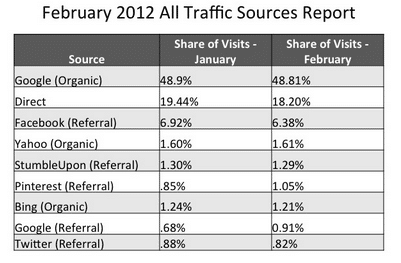The ongoing interest in Pinterest… are you on board?
Just when you thought there were enough social media sites out there, along came Pinterest. The two-year-old site has exploded, and now hosts over 11.7 million active registered users who spend an average of 15.8 minutes per visit on the site. With that kind of community, it's no wonder the web is ablaze with stats and tips on how to pin your way to a web victory. We've combed through it all in order to present you with the most useful guide to 'Pin and Win' in the international education game. After a quick background on the site's users, we then offer up a wealth of creative and practical tips to help you maximise this new, highly addictive marketing tool.
Is it really working?
First, some quick statistics to show you just how powerful Pinterest is becoming - this is not a fad you want to ignore.
A recent article from Mashable revealed that Pinterest drove more traffic to online publishers in February than Twitter. And in January, Shareholic found that Pinterest sent more referral traffic to publishers than Google+, YouTube and LinkedIn combined.

It's a girl thing... or is it?

Yes, the rumours are true - about 68% of Pinterest users are female... in the US. This article spilled the beans that in the UK, the majority of users are male, and as you can imagine, their interests are vastly different, focusing on more business-oriented areas such as content management and public relations, which suggests that Pinterest is also a great avenue for B2B networking. Demographics in America show a strong variety of ages, meaning you can use one platform to reach not only students, but their parents as well. Click on the infographic (to the right) created by digital advertising agency Modea for an up close and personal view of Pinterest's users.
Okay, I'm convinced. Now what?
There are two things we can't stress enough: 1. Avoid self promotion. This is a chance to help your followers, provide useful information, inspire others and ask questions. It's naturally a good place to include brochures, images and video interviews or tours of your school, but you'll need to think a bit more creatively than that. 2. This is not a billboard. This is a social board. When building your account, remember that it should represent your brand lifestyle. Your account is a reflection of your brand's beliefs, traditions, values, mission and the value that international education provides. Let's not forget how empowering education is. As Tnooz points out, users are not sharing images of their current life, travels or memories (a la Flickr and Facebook), but rather hopes, dreams and plans for the future. Does your school teach Mandarin? Then demonstrate what people can do with that language once they've learned it. Has your agency sent hundreds of students to learn Spanish in Seville where they can taste the local tapas and get hypnotised by the rhythm of flamenco? Then tap into people's desire to travel and experience another culture firsthand. This is also where collective marketing comes into focus. Harness the power of your location (be it city, state, region or country) to showcase what lies beyond your school's doors.
How do I get started?
Before you create your own account, we suggest you sniff around a bit on Pinterest. Do a search on your school's name, or even just a term like 'university' to see how students are using the site. You may find several students have created boards in their accounts for their (read: your) school, so reviewing what they have pinned will give you a good idea for what has the most 'pin appeal.' Another handy trick to see what has been pinned from your website or blog is to use this specific URL: http://pinterest.com/source/ADD YOUR URL HERE (or using Concordia College as an example: http://pinterest.com/source/cord.edu). Social Media Examiner suggested a hefty 26 tips when using Pinterest, and if that isn't enough, then check out these 56 tips from Copyblogger. But don't feel overwhelmed - we've picked out a few of the gems here:
- Pinterest’s integration with Facebook is still only for personal profiles and not fan pages, therefore, you should choose the email associated with your brand’s Twitter account to set up your Pinterest profile.
- You can choose to either keep the profile photo that’s been pulled from your Twitter account or upload a new one. You can also alter the name and email associated with your account, add a location, website and a brief description of your brand.
- When creating a description for a new pin, you can optimise the pin by adding keywords that users may be more likely to use if they’re searching for specific content on Pinterest. Like Twitter, you can also tag people using the @username function and add multiple hashtags (keywords) at the end of your description. There is no limit to the number of hashtags you can use, but beware that too many hashtags can look like spam.
How can I be pin perfect?
We noticed that many university and college boards show images of beautiful school buildings, sports paraphernalia, accessories in school colours... these are a great start but be sure to go beyond the norm. This is your chance to show off the softer side of your brand, so take full advantage of that by creating a space which shows some personality and inspiration. After all, those are the items with the most appeal and sharing power. To create a personal touch, showcase your staff's thoughts, actions, feelings, dreams or backgrounds, such as what schools they went to, what languages they speak, their favourite study abroad destinations, etc. You can do the same with your alumni, and by asking them to generate this content, your engagement levels start jumping. And don't forget to showcase the awards your staff has won as proof of the quality your school or organisation provides. If you offer exam preparations, for example, consider a board for things to help someone relax before an exam, as well as ways to celebrate after the exam. You can also share worksheets and homework materials, with different boards for different lessons or classes. We're in the education game, so why not teach someone how to do something? Create several "How To" boards with videos showing how to pronounce words or phrases in a foreign language, how to get from your school to a great cafe in town, or even practical tips like how to fill out an application form. Looking for some cool infographics to promote study abroad or education? You're sure to find one amongst the nearly 500 items here. Ready for some more ideas? How about an event coverage board - as highlighted in this piece offering tips on how to use Pinterest as a brand - imagine a board with behind-the-scenes images from a student fair your school attended. Or, this article provides some additional marketing guidance such as running contests on Pinterest. Your Pinterest account is a great way to creatively market to prospective students and their parents, as well as current students and alumni (Concordia College and Drake University are two inspiring examples, and Brand Manager's Notebook created a handy directory of schools using Pinterest). Let's not forget about your partners - agents will no doubt also find a school's Pinterest account a useful tool when presenting the benefits of studying there. Whether it's to show off the school's spirit at sporting events or provide evidence of support services like career centres, clubs or the technology students have access to. As your account grows, continue to look at the pinners who follow your brand to see what they’re pinning and who else they’re following. You have full exposure to their interests and passions, as well as the latest trends (from college majors to work and travel destinations), so use that knowledge when engaging with them. Be sure to add a "Pin It" button to your online marketing properties to encourage engagement, and don't forget to drive traffic back to your website whenever possible so you can track your results and increase conversions. Pinterest supporters view the platform as a unique way to build their brand and connect with others. This highly addictive channel is also used as a proactive sales tool to gain new customers and retain customer loyalty. Finally, through virtual word-of-mouth mentions and referrals, it expands your web visibility. If we haven't convinced you yet, then you'll have to just take our word for it - Pinterest's many benefits should make it a key component of your marketing mix.
















